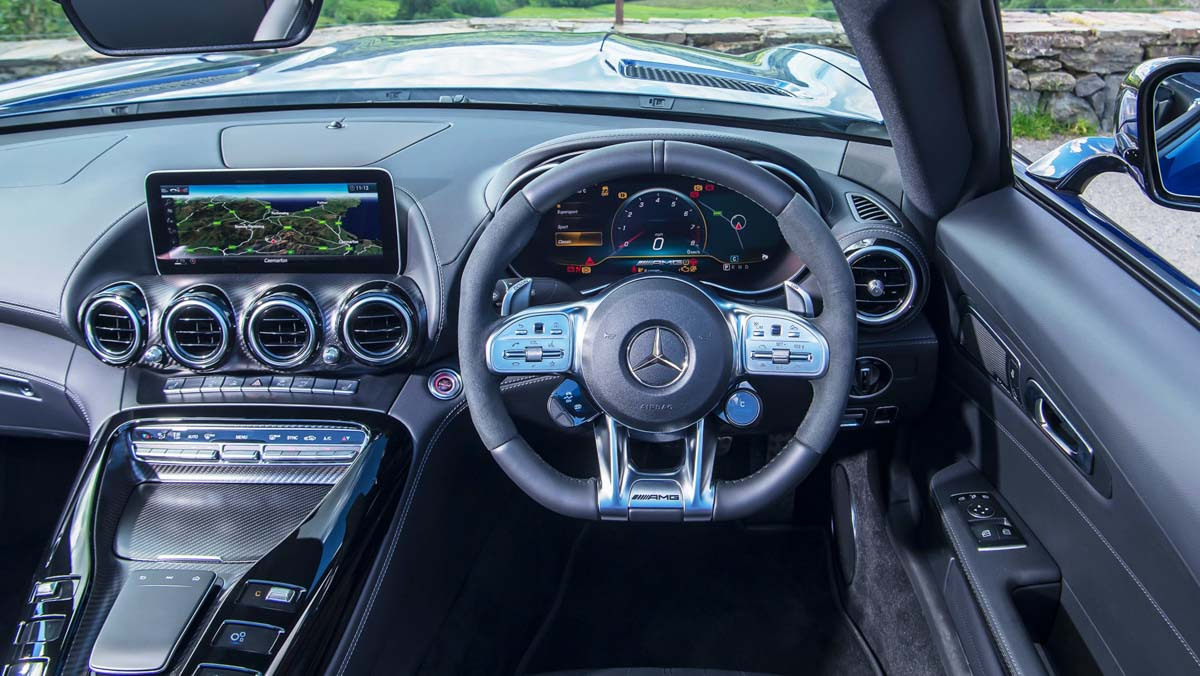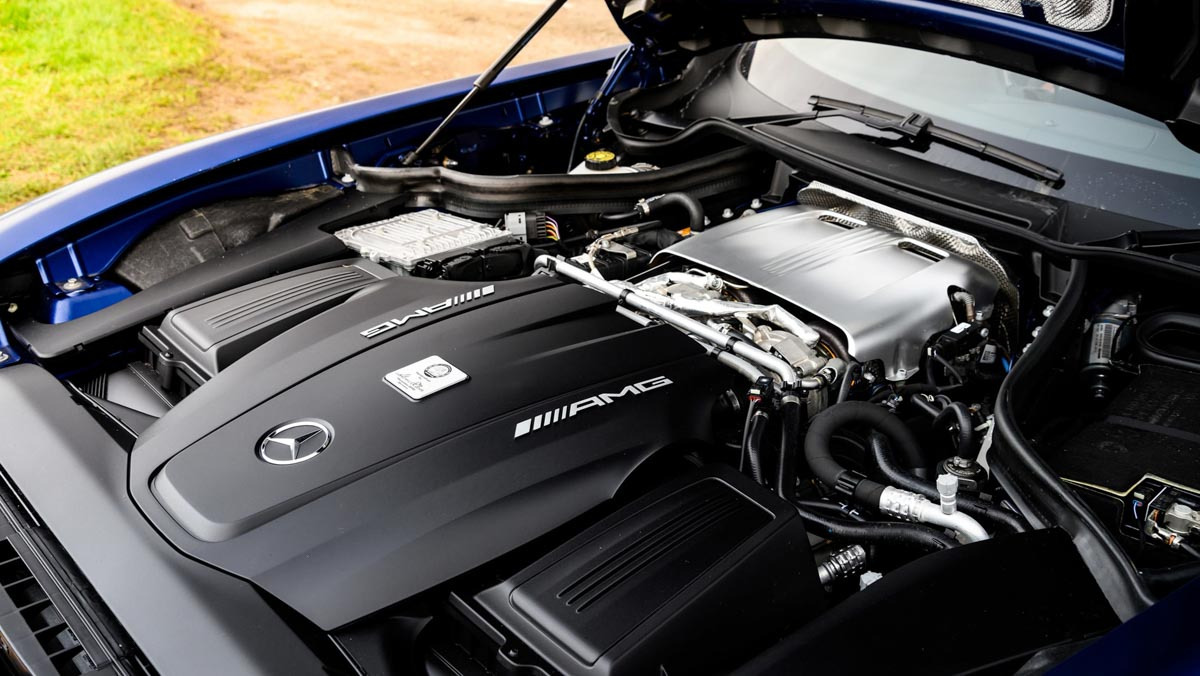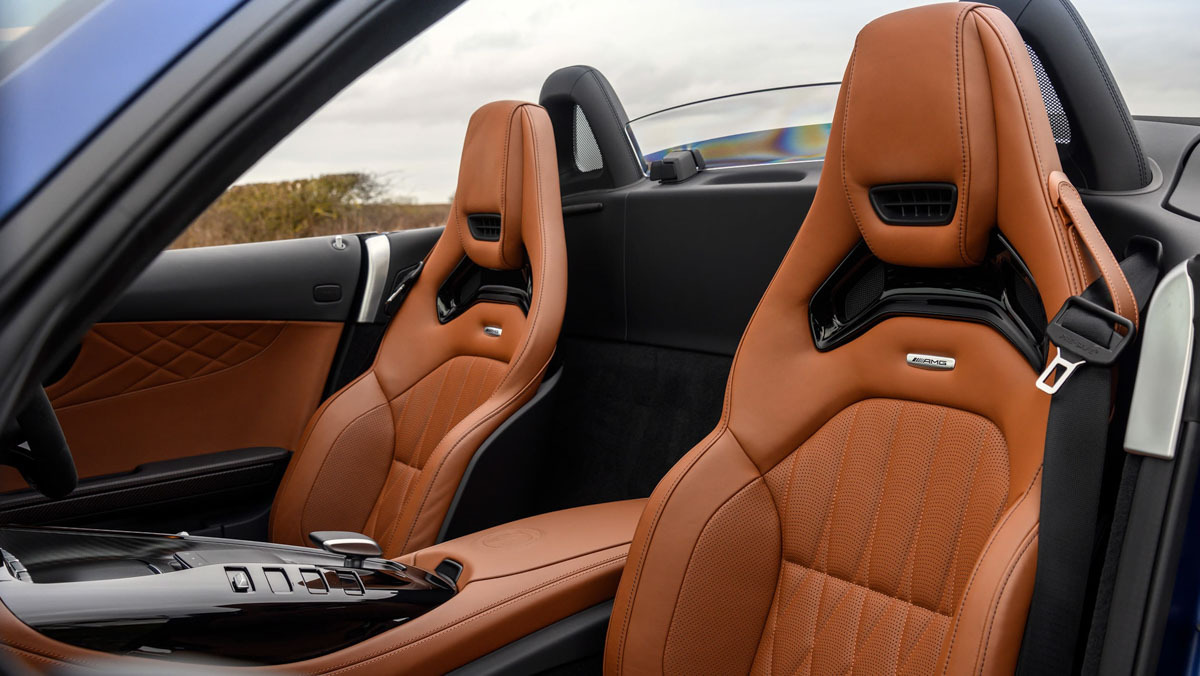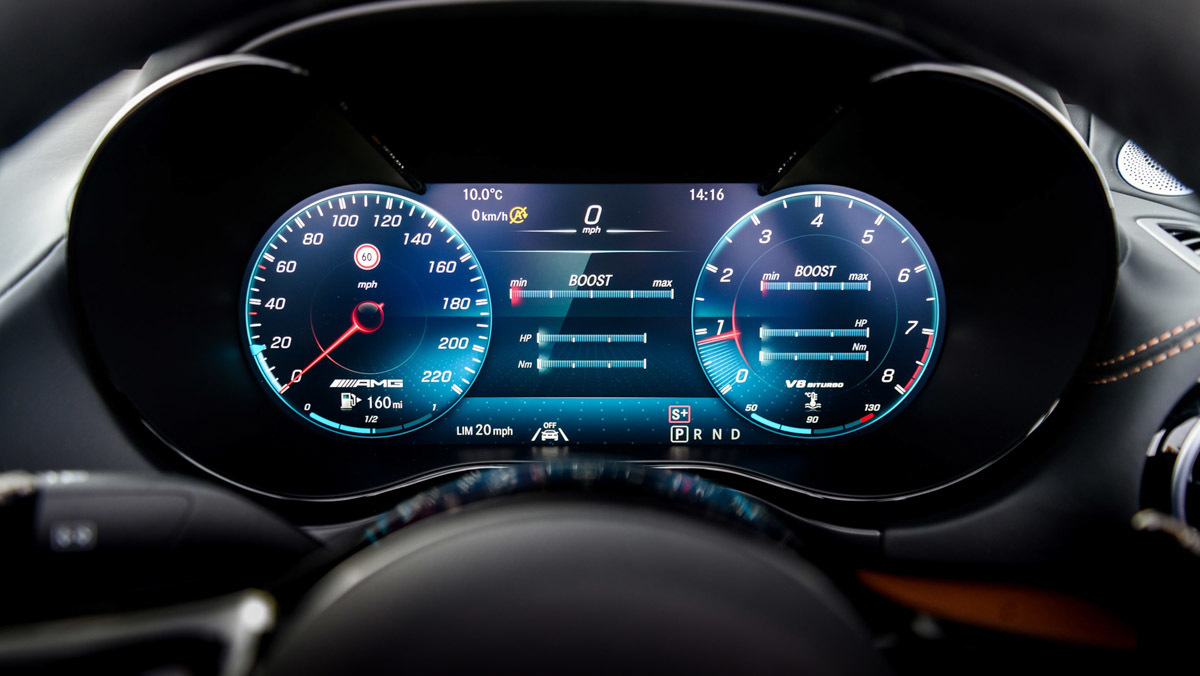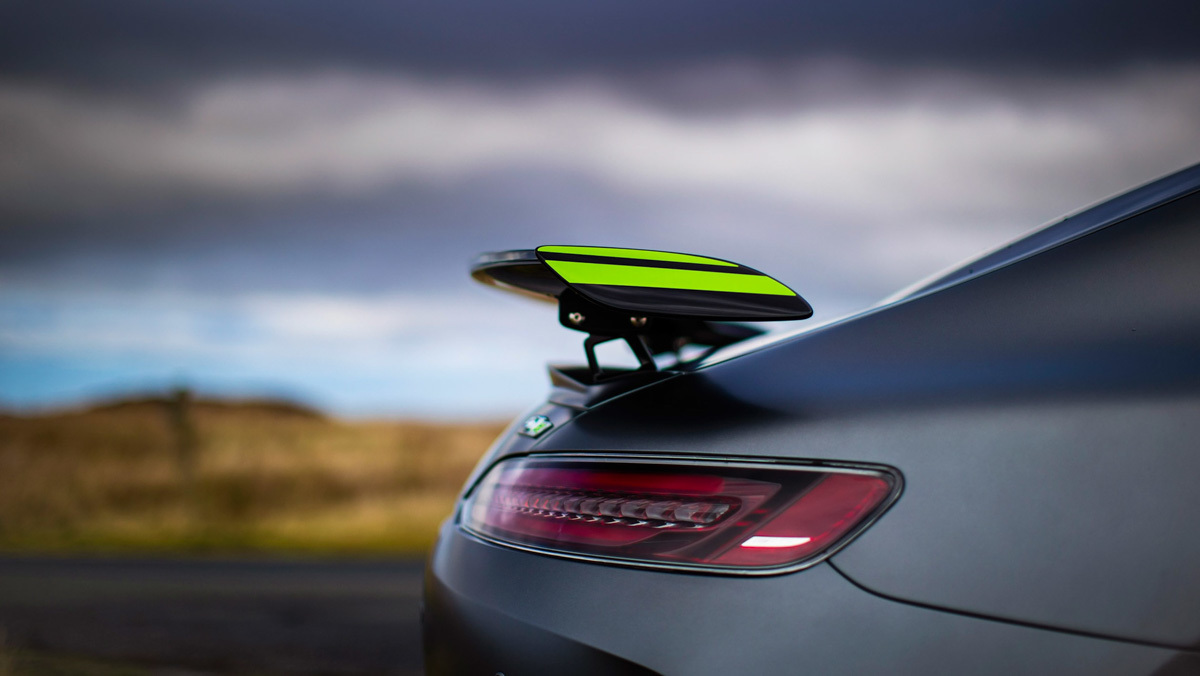The engine dominates what is a captivating and distinctive performance car awash with character.
The Mercedes-AMG GT has been through quite a transformation since its debut in 2016. Initially revealed as an R8-rivalling junior supercar with more than a bit of the previous SLS’s charisma, it’s since made headlines by breaking Nurburgring lap times and placing runner-up at our 2019 Car of the Year test respectively in its hardcore Black Series and GT R Pro forms.
But below these headline-grabbing flagships, the lesser GT has continued down its own path of subtle tweaks and updates to keep in touch with its junior supercar rivals. As of 2021 the range has been consolidated to an entry-level GT in Coupe and Roadster forms, a GT C Roadster, the GT R Coupe and the range-topping Black Series Coupe.
Base prices have gone up across the board, but to compensate the ‘base’ GT has seen a power and equipment boost. While the GT may lack the range or powertrain variety of some rivals, its front-mid engined layout and hot-rod proportions keep it as a distinctive and desirable addition to the sub-supercar class.

Prices, specs and rivals
The simplified AMG GT range kicks off at around $145,000, or around $13k more than its initial launch price. Over time the basic car has picked up a more potent version of its V8 powertrain essentially replacing the previous GT S, and that goes some way to explain this price rise. Standard equipment has been given a bump, but it’s the staggered 19/20-inch wheel set, uprated brakes and electronically controlled limited slip differential that are the important upgrades.
An optional ‘Night Edition’ package is also a new addition for 2021, which for under $13,000 adds a selection of blacked-out visuals, adaptive dampers and a carbonfibre roof. The GT Roadster is priced from around $16,000 more than the hard-top.
Above the standard models, the GT range splits into the Coupe-only GT R and Convertible-only GT C. Each of these models were previously available in both body styles, but for 2021 have been consolidated to each offer just the single option. On top of its small power bump to 557bhp, the $209,000 GT C Roadster features rear-wheel steering, a different wheel design, higher-spec leather trim inside the cabin and the option of carbon ceramic brakes.
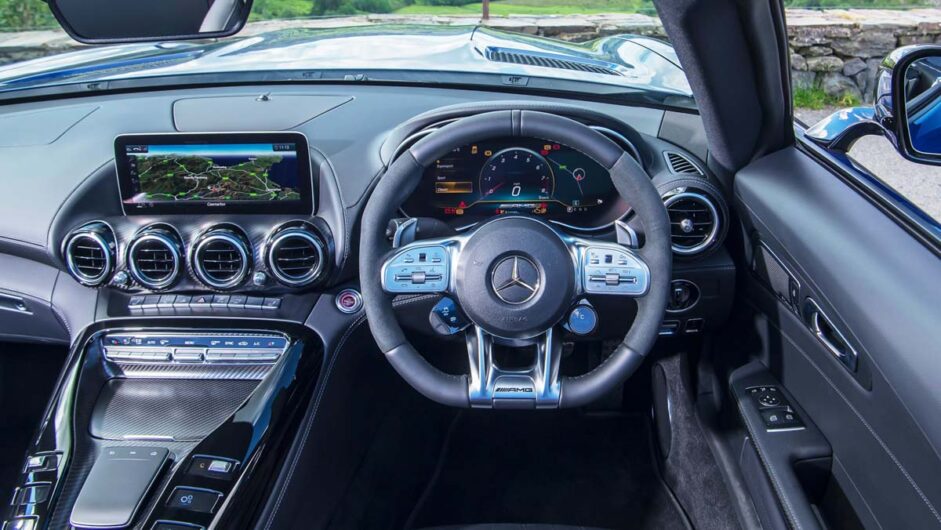
At over $215,000, the GT R takes things further, which aside from its many technical upgrades around the powertrain and chassis, also brings bucket seats, a load of Alcantara and AMG’s nine-stage traction control system accessible via the dash-mounted twist knob. As with the GT C, 402mm carbon ceramic brakes are an option.
A six-figure Porsche 911 is not a hard thing to specify in the latest 992-generation, making it an extremely capable, if not quite as dramatic, rival to the big AMG. Audi’s R8 is priced from $158,000 for the base R8 RWD, aligning it to the GT Night Edition model, while the full-fat 612bhp R8 Performance gets closer to the GT R at $195,000.
Aston Martin’s $166,000 Vantage is another alternative, and while it may share the GT’s V8 (albeit not in dry-sumped form) it’s a markedly different experience, feeling like more of a British thug compared to the AMG’s hot-rod demeanor.
Engine, gearbox and technical highlights
The GT’s M178 engine is the dry-sumped brother of the M177 engine found across AMG’s range. That means it has a displacement of 3982cc and two turbochargers residing in the 90 degree V. In standard GT form it produces 523bhp between 5500rpm and 6750rpm, around 50bhp more than it did at launch. Like all AMG V8s, torque is also strong, peaking at 494lb ft on a plateau between 2100rpm and 5500rpm. GT R models up the game with 577bhp at 6500rpm and 516lb ft, figures that put it ahead of key rivals like the Porsche 911 GT3, but short of the brawniest Audi R8 Performance.
On both road and track, performance of the Mercedes-AMG GT never feels anything less than ballistic. Despite being turbocharged, throttle response is fantastic, punching you out of every corner and actually matching the alacrity of the handling. The V8 then hauls with an unrelenting ferocity down the straights, reeling in the horizon in an almost surreal fashion. With the exhaust button pressed, all this is of course overlaid with a soundtrack that gargles blood and thunder like some sort of tetchy Norse god.
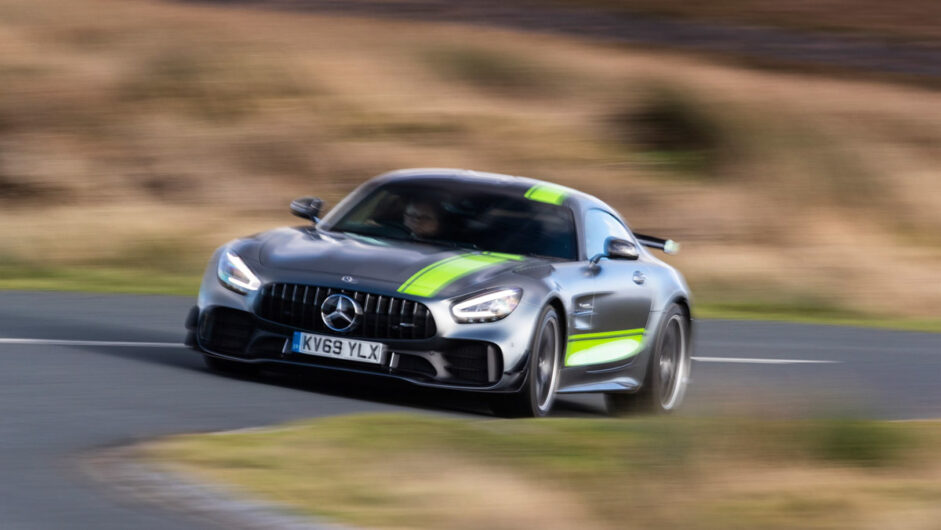
Where fast Mercedes models of the past have often fallen a little short is in the gearshift. However, AMG has got it sorted with the GT. The seven-speed dual-clutch ‘box cracks through upshifts as smartly as you like, but more importantly it will also down-shift when you ask it to. It still can’t quite match a Ferrari ‘box for overall downshift speed and theatre but the mere fact we’re making the comparison means it is a huge step on.
The GT Black Series goes on its own path, holding onto the same underlying engine architecture, but swapping out the traditional cross-plane crank for a supercar-style flat plane crank. This makes the V8 inherently better balanced, allowing engineers to pack a whole lot more performance into it without the engine shaking itself to pieces. The compromise comes in its aural quality, which sounds far more like a four-cylinder than its exotic ingredients would suggest. Still, the Black Series’ figures are well beyond any GT so far, with 720bhp at 6700rpm, with torque also up to 590lb ft.
Performance and 0-100 time
The ‘base’ GT is an extremely brisk supercar, reaching 100kph in 3.8sec in both Coupe and Roadster forms, topping out at 312kph. The Roadster-only GT C cuts this back by a further 0.1sec to 3.7sec and raises the top speed to 315kph.
The AMG GT R drops its 0-100kph time to 3.6sec, while top speed increases to 318kph. As for the numbers, they don’t necessarily do the AMG GT’s performance justice. This is a car which is well and truly about the perception of speed, in that it feels much faster than it is through a combination of factors.

Sat low, with a long bonnet stretched out in front of you, the GT feels like a hotrod, totally and utterly dominated by the V8 engine in front of you, yet with the broad torque and response expected from a contemporary supercar engine. Throw in the incredible exhaust note and you have a straight line experience that’s both intense and immersive beyond what the already impressive numbers suggest.
We’ve yet to drive the GT Black Series but where the standard GT models appeal with their V8’s character, the Black Series’ application of a flat-plane crank makes it a very different engine that will be defined mainly by its performance. Still, the 3.2sec 0-100kph time is deeply impressive for a front-engined rear-wheel drive car, and while it is the only GT model to crack 321kph (323kph to be precise), top speed was certainly not the priority given the aero pack fitted.
Ride and handling
Open the bonnet of the GT and you will see what looks like an engine cover, but it’s no such thing. Look behind the big piece of black plastic, up towards the windscreen, and you will see the actual location of the engine. This is one of the most extreme examples of a mid-front-engined layout ever to grace a road car and you can feel it in the handling. The front end response is incredibly quick, the nose darting into corners at the slightest provocation.
With the dampers in the most comfortable of their three settings there is a nice bit of roll, but ramp them up further and the AMG GT corners incredibly flat and very fast. It is perhaps the direction changes that are the most impressive aspect, the whole car slicing one way then the other with no need for any pause in the middle. This lateral stiffness can initially make the car feel quite aggressive at the limit, really fighting not to lose grip, but actually the electronically controlled LSD smoothes the transition into slip well.
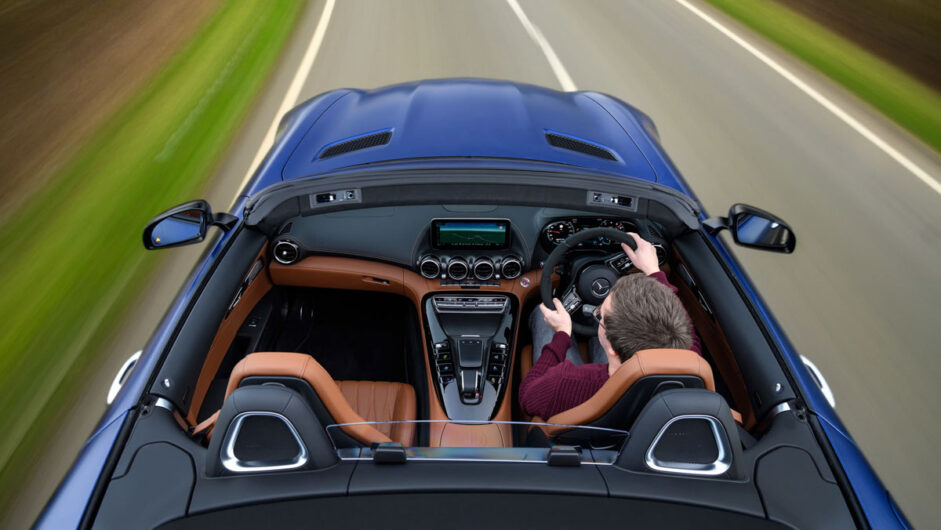
The one note of caution in the AMG GT is the steering. It is extremely quick, which you get used to, but it is also extremely light and at times this can leave you feeling a bit removed from whatever the grip levels are at the front wheels. The sensations improve once you have some lock on, but heading down a straight towards a corner you can be a little nervous about that initial input. This feeling is exacerbated by the feeling that you’re essentially sat over the rear axle, placing you behind the car’s natural axis of rotation which exaggerates cornering forces, even if cornering speeds aren’t actually that high. Of course this isn’t a problem on track and if you have an inclination towards oversteer, then the AMG GT will indulge you for as long as it has tyres and fuel.
The GT R takes things to another level, with more power and features such as rear-wheel steering to refine the experience. In both models, the feature provides the driver with the impression that the car has a shorter wheelbase, with the front wheels being closer than they actually are. At speeds up to 100kph the rear wheels turn in the opposite direction to the front wheels, and above 100kph they turn in the same direction as the fronts, making the car more stable.
L/100km and running costs
Strangely, all GT variants including Coupe, Roadster, GT C and GT R have an identical 4.8L/100km combined rating on the WLTP cycle. Drive with restraint and these numbers will be achievable too, given the comparatively low-strung nature of the M178 compared to the 600bhp-plus applications in larger and heavier AMG models.
All models also have similar 290g/km CO2 ratings give or take one or two grams, which puts it in the same top road tax bracket as a Jaguar F-Type R and crucially, most Porsche 911s. A three-year unlimited warranty along with service intervals of 20,116 kilometers or every 12 months, makes the AMG GT a fairly easy to live with ownership proposition.
Interior and tech
Like so many aspects of the GT, the experience from within the cabin is driven by the car’s proportions. The seating position is low, with a wide, ungainly console rising to meet the flat broad dash. Its windscreen is upright and sits closer than you would otherwise expect, with the bonnet stretching out to what feels like the horizon. It’s an experience that’s markedly different to what you get in an R8 or 911, their low-scuttles opening up great visibility.
The GT’s low and wide stature is only compounded by the four-wide air vents, atop which sits the infotainment screen that controls generation-old software. A second high-resolution colour screen has also replaced the previously analogue dials ahead of the driver, while the steering wheel is a unit borrowed from other AMG models which looks oddly shaped and uncomfortable but is quite comfortable and intuitive to use.
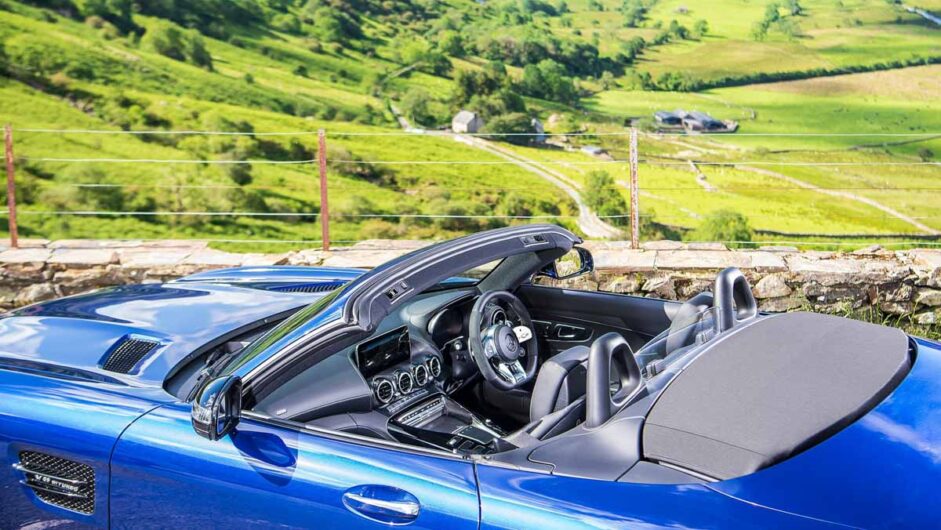
The centre console is a highlight. It has a clever arrangement of buttons made from eight tiny colour screens designed referencing the V8 sat beneath the bonnet. Everything from driving dynamics to the exhaust is controlled via these 8 buttons, each changing the display actively depending on the chosen setting. It’s certainly clever, if possibly overkill. These are then joined in some models by the same colour-coded screen controls attached to the steering wheel offering the same functions.
Overall quality is impressive too, and while it might lack the tech of a modern 911, or theatricality of an Aston Martin Vantage, the interior is an impressive element of the GTs package. Black Series and GT R models both build on this basic cabin architecture with subsequently more aggressive bucket seats and optional roll-cages, but the basics remain unchanged.
Design
Much like the interior, the GT’s exterior design is driven from its proportions as much as its adherence to Mercedes design language. In 2018, the all GTs had the biggest of their minor updates, with an application of the Panamerica grille seen on the GT as well as some fresh wheel and bumper designs.
There are two body-widths available, the narrower of the two utilised by the standard GT and identifiable by its lack of vents on the rear bumper and four round exhaust outlets. GT Rs feature the subtly wider body, more prominent front splitter and small rear wing, sat above a natty triple exhaust system with a single central outlet flanked by two supplementary outlets integrated into the diffuser. The GT C combines the wide body with less aggressive elements, losing the R’s aero devices.

GT R and GT Black Series models technically share the same wide-body, but the latter takes things much further with its bespoke carbonfibre body panels and a big aero inspired by AMG’s GT3 racer. On the bespoke tailgate is a huge adaptive bi-plane rear wing that’s nearly as big as the one seen on the GT3 car, with an aggressive rear diffuser and quad exhaust layout below. Up front, the Black Series takes the Panamerica grille all the way down the nose to its front splitter, dominating the face like the grate on a Victorian wood furnace.
This article originally appeared at evo.co.uk
Copyright © evo UK, Dennis Publishing



